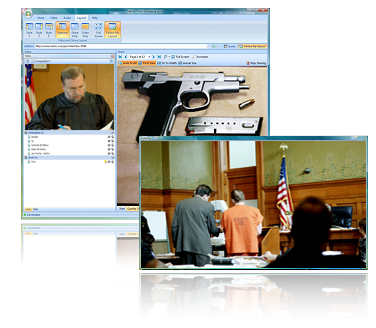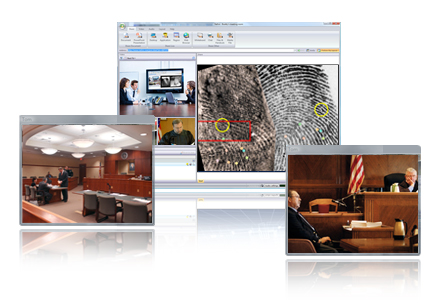Video Conferencing Expedites
Court Arraignments and Helps Increase Visitation
 Key
advancements in video peripherals, multicore PC processors, Internet bandwidth and video conferencing
software and online services now assist in bringing cost-effective web and video conferencing to business and
governments around the world.
Key
advancements in video peripherals, multicore PC processors, Internet bandwidth and video conferencing
software and online services now assist in bringing cost-effective web and video conferencing to business and
governments around the world.
Among the many applications of this technology here in the U.S., video conferencing is being used to help
speed court hearings, depositions and bring families separated by law or incarceration together more often.
Video Visitation
Video technology is now powering one-to-one and multiparty video visitation in prisons and bringing parents and
children who may live thousands of miles apart together to spend quality time virtually. For prisons, not only does
video help inmates connect with family members, it also helps reduce costs for the correctional facility, increases
public safety efforts and expedites the judicial process.
The New Jersey Department of Corrections may be one system that is on the cutting edge when it comes to adopting
video technology to help reduce operational costs. Through a joint partnership with the Administrative Office of the
Courts, Office of the Public Defender, the State Parole Board and private vendors, a system-wide and alternative
approach to criminal justice proceedings has been implemented in New Jersey successfully.
Major objectives for the Video Teleconferencing Program in New Jersey include providing system-wide access to the
inmate population for criminal justice systems at all levels, State, County, Local and Federal, enabling each to
conduct business in a more efficient manner. But beyond the business operations efficiency, there are other inmate
benefits afforded by the Video Teleconferencing Program, especially for inmates in the Edna Mahan Correction Facility
for Women in Clinton, New Jersey, and the New Community Corporation's Harmony House in Newark. This extension of
the program is a natural progression in both expanding services to inmates while keeping security in tact for the
general public.
The benefits of the program far outweigh any disadvantages. It has been successful in enabling inmates to connect
with their children that because of transportation issues, etc., are unable to keep regularly scheduled visits. A
central videoconferencing site for family members is located in downtown Newark. Not only is this a cost-effective
and convenient alternative to in-person visits, it encourages family responsibility in female offenders and further
cements the bond between mother and child.
Overburdened courts and busy attorneys throughout the country are realizing that video conferencing can indeed
help to speed the legal process by enabling deposition and arraignment testimony to take place outside of the
courtroom via video.
Video Arraignment, Telecourt & Telejustice
The City Court and 14th Judicial District Court in Lake Charles, Louisiana, are good examples of how IP-based
video conferencing technology can accelerate the judicial process by allowing judges to hold court proceedings,
either arraignments or "Assignment of Counsel", remotely which eliminates the need to transport prisoners
to and from the courthouse or requiring judges and minute clerks, who record the
 proceedings, to travel to the jail. During arraignment proceedings, the judges in the District Court are able to
see and hear the inmates' pleas in real-time while a minute clerk takes record of the arraignment session. Before
deploying video conferencing software, inmates were securely transported to the courthouse for arraignment on
previous misdemeanor charges.
proceedings, to travel to the jail. During arraignment proceedings, the judges in the District Court are able to
see and hear the inmates' pleas in real-time while a minute clerk takes record of the arraignment session. Before
deploying video conferencing software, inmates were securely transported to the courthouse for arraignment on
previous misdemeanor charges.
The court in Lake Charles has increased the arraignments from approximately eight to 30-50 per week. The 14th Judicial
District Court and Lake Charles City Court replaced a traditional, point-to-point video conferencing system that cost
more than $30,000 with inexpensive standard audio and video peripherals and PCs found in any retail electronics store.
The new IP-based video conferencing system is easy to use, requires little or no training and minimal system maintenance.
For more information, please visit the 14th JDC case study.
Video Conferencing Bridges Distance in Parent-Child Visits
The goal of video visitation, from a family and friend perspective, is staying in touch. While it will never take
the place of being there 'in the flesh' it does provide the benefits of seeing and talking to the person
you're visiting with as if you were in the same room. Virtual visitation is an evolving trend in child custody
arrangements. Families split apart by divorce may also be separated by states, or in some cases, even countries.
While electronic communications, including email, instant messaging, telephone or other wired or wireless
technology can never take the place of communications and interaction with a parent in-person, video visitation
can be used to keep in touch on a regular basis and to supplement in-person visits.
Some states support the use of video visitation as a means to interact and bridge the distance between relocated
children and their parents, some legal experts believe it may be used as a reason to grant relocation to the
custodial parent. For video visitation to work effectively, states must develop specific requirements that do not
allow custodial parents to use new technology to relocate far away from the other parent. The real end goal of
visitation is to allow parents to visit with their children, to provide more quality time and a more superior way
to communicate.
Although the phone is better than nothing, it is one-dimensional and most would agree that children under 12
have a difficult time holding a conversation for any length of time. There is no disputing the fact that video
visitation provides a better platform, than the phone or email, for parents and children to connect. And, it's
just one more way to bring parents and children closer together despite geographic disparity.
Video Conferencing Hardware Alternatives
There are a variety of web and video conferencing alternatives. There are traditional, point-to-point solutions
that may offer only video and are sometimes complex to install and use. These systems are very expensive, as the
14th Judicial District in Louisiana found out. There are also proprietary video conferencing systems specially
designed for use in court depositions and prisons. One of the most flexible options is IP-based web and video
conferencing, which is available as a hosted service or on-premise software. The advantage to buying and installing
the web and video conferencing software is the ability to control its use, secure the conference content behind the
network firewall and the Return on Investment (ROI). Depending on how often and how many individuals will concurrently
use the application, will ultimately define how expensive it will be to use and operate regularly. IP-based video
conferencing utilizes the TCP//IP network protocol to connect users, generally two ore more, between remote locations
– either public or private Internet connections. This solution also is the most cost-effective because it runs
on standard PCs, web browsers and high-speed Internet connections with
off-the-shelf video and audio peripherals.
Most IP-based web and video conferencing software solutions offer various security options. Some of the best also
include features that allow IT staff to set encryption standards, such as SSL or TLS, and offer the ability to make
settings that require all conference
connections be SSL/TLS secured. The ability to integrate the web and video conferencing solution with the
customer's existing Public Key Infrastructure (PKI) is an added option that may be available in some applications.
Nefsis Web and Video Conferencing
Nefsis is a comprehensive IP-based web and video conferencing solution that is available as an online service and
on-premise software. It provides security options that meet the most stringent security policies and is ideal for
real-time multiparty video conferences in any public or private sector organization. It's as easy to use as any
Microsoft Office application.
Video conferencing, once found only in boardrooms in large companies that could afford the extra expense, is now
being used throughout the world in a variety of applications. The soft benefits of speeding up the judicial process
and bringing justice more quickly to those that are incarcerated, improving security, plus more frequent communications
between remote offices, and bringing staff or family members closer together may be invaluable. But more importantly,
video conferencing is now providing hard cash savings to court systems.
Additional Resources:
http://www.state.nj.us
http://www.orangecountyfl.net
http://www.14jdc.org

